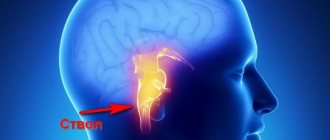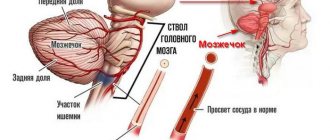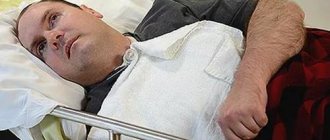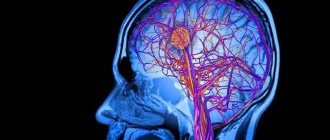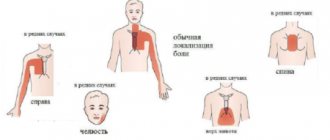Causes of pathology
The occurrence of the disease is observed in the absence of the brain receiving appropriate signals. In some cases, the reason is that the brain receives a pathological signal. Against this background, malfunctions in the functioning of the nervous system are diagnosed.
If the sympathoadrenal system does not work correctly, this leads to the development of pathology. If a patient's blood pressure increases, catecholamines are released into the blood in large quantities.
In a complicated hypertensive crisis, a large amount of blood enters the brain against the background of massive vasodilation. The sympoadrenal system contributes to the manifestation of vasodilation. In parallel with this, the center of the brain is stimulated, which controls the functions of the digestive tract and is responsible for the gag reflex.
People over 55 years of age are at risk of developing the pathological process. Vomiting and nausea occur with increased blood pressure. The cause of the pathology may be a hereditary predisposition.
If the patient has close relatives who suffered from the pathology, then he is at risk. Vomiting and nausea appear in people who suffer from senile atherosclerosis of blood vessels. If a person has diabetes but does not control their blood sugar levels, this will lead to symptoms.
Vomiting after a stroke occurs according to a special mechanism. That is why, after an attack, it is recommended that the patient be urgently referred to a medical center.
Nausea and vomiting during stroke: causes, mechanisms, what it means, prognosis, help
A stroke is characterized by the rapid development of symptoms that intensify with hypoxia and death of brain cells. Acute cerebrovascular accident threatens hypertensive patients, people who abuse fatty foods and lead a passive lifestyle. Often, assistance for a stroke is not provided in a timely manner, which is why the disease causes numerous complications and post-stroke disorders. The first signs of illness are not always so obvious.
Stroke may cause nausea and vomiting
One of the early symptoms of a stroke is nausea and vomiting. The ailments can continue for several hours, gradually increasing to complete numbness of the left or right side of the body, brain cognitive impairment or fainting. It is necessary to catch warning signs in time and seek help while it is still possible. So why is nausea one of the symptoms of a stroke, and when does it come to vomiting?
First aid - video
Before the doctor arrives, the patient is advised to provide first aid. It consists in performing a certain algorithm of actions. This will eliminate the possibility of the patient choking on vomit.
- It is recommended to place the patient on a flat surface. His head must be raised at an angle of 30 degrees. For this purpose, a cushion or pillow is placed under the neck.
- If there is an attack of vomiting during a stroke, then the patient’s head is turned to the side. This will eliminate the possibility of aspiration of vomit. At the end of the attack, the patient’s oral cavity is thoroughly cleaned.
- If the patient has dentures, it is recommended to remove them if they vomit.
- All objects that could cause pinching are removed from the patient’s neck - chains, ties, etc.
If the occurrence of a hypertensive crisis is observed after eating, this indicates a hemorrhage in the brain. This can lead to a gag reflex and vomit entering the respiratory tract. Against the background of such a process, death becomes a complication.
First aid is aimed at cleaning the mouth from vomit. In this case, it is necessary to constantly monitor the patient’s eating patterns. During the period of first aid, you need to ensure that the patient does not eat.
Nausea occurs in a person before a sharp increase in blood pressure. Therefore, during an attack you need to measure your blood pressure. When it increases, it is recommended to take antihypertensive drugs - Nifidipine, Captopress, 25% solution of magnesium sulfate. This will eliminate the possibility of cardiovascular disease.
If possible, before the ambulance arrives, the patient is given 2 milliliters of Cerucal or Metoclopramide . With the help of the medication, an attack of nausea is eliminated. Patients may experience nausea on a constant basis, which indicates a psycho-emotional catastrophe.
Every person should know what to do when vomiting after a stroke. This will provide emergency assistance and eliminate the possibility of developing a variety of undesirable effects.
Diagnostic features
If a stroke occurs, the patient experiences not only nausea and vomiting, but also other symptoms, which makes it possible to determine the disease independently. Patients experience cognitive and motor impairments. If a person experienced nausea for 7 days and then disappeared on its own, then this may indicate a micro-stroke that was suffered on the legs .
Most patients with such ailments do not even seek help from a doctor, as they consider attacks of nausea and vomiting to be signs of illness. If unpleasant symptoms occur, it is recommended to seek help from a medical center, as the risk of a recurrent attack is very high.
After the patient arrives at the medical center, he is examined by a doctor and takes a medical history. This allows the specialist to make a preliminary diagnosis. To confirm it, it is recommended to use laboratory and instrumental techniques.
The most commonly used are magnetic resonance and computed tomography. If a patient is diagnosed with an ischemic stroke, then vomiting is not observed. The exception is an acute disorder in the brainstem. These diagnostic techniques allow you to determine the location of the pathology and prescribe effective treatment. If a stroke is suspected, which is accompanied by vomiting, ultrasound Dopplerography of blood vessels and echoencephalography are recommended.
If a stroke is suspected, differential diagnosis is recommended. It is recommended to distinguish the disease from poisoning or other gastroenterological diseases. This symptom can appear with sunstroke. It is diagnosed during a concussion, which has varying degrees of severity. Stroke must be distinguished from intoxication, which develops against the background of exposure to various chemicals.
Nausea and vomiting are additional signs of a stroke. With pathology, the patient experiences cognitive impairment in the form of decreased memory and concentration. The patient is diagnosed with loss of orientation in space. The pathological process is accompanied by speech disorders. Patients experience weakness in one limb or paresis on one side of the body. If several of the above symptoms or the whole complex occur, it is recommended to urgently call an ambulance.
Diagnosis of vomiting and nausea during a stroke should be comprehensive, which will eliminate the possibility of other diseases and prescribe comprehensive treatment.
Grandmother doesn't eat after stroke and feels sick from eating
Doctor of Medical Sciences, specializing in neurology, professor. Doctor of the highest qualification category. Medical experience over 25 years. Area of professional interests: acute and chronic pain, osteochondrosis, back pain, joint pain, headaches, neuralgia, etc. Acute and chronic vascular diseases, stroke, discirculatory encephalopathy, consequences of strokes, arterial and venous disorders, vegetative-vascular dystonia, etc. Asthenic conditions, chronic fatigue, memory and attention disorders, neurotic disorders, etc.
Difficult cases. The author's methods of quickly working with the patient's subconscious, restoring his internal resources. On our project. More diseases.
Ordering medications. First aid. Ask a Question. After a stroke, my grandmother does not eat and is sick from eating. Artur G, Woman, 76 years old. My grandmother suffered a second stroke. As the doctors told us, there were no consequences in the brain. However, the first stroke left a hematoma in my head. Plus, the first stroke affected the left side of the body, and the second brought partial paresis of the right side of the body. The stroke occurred in mid-September.
At the end of September we took my grandmother home. Grandmother became bedridden. We sat her on the bed for the first time after the hospital, but then she became weaker and weaker. And one of the reasons for her weakness is that she vomits while eating. Literally, as soon as you bring a spoon to your mouth, it’s already “pounding” all over.
She coughs as if she was choking. Now we feed her lying down, we tried sitting - the situation does not change. And recently my grandmother started coughing even from drinking water. It was not possible to do an FGD in the hospital - the grandmother begins to suffocate. She refuses to drink broths or milk - we just trick her into slipping them to her when she asks for water. She also had her gallbladder removed. Doctors say that they can’t do anything without FGD. They prescribed some medicine for bloating, like Motilum. Blood was taken, almost all indicators were normal or not critical.
Her urea levels are elevated, but we regularly give her diuretics. When my grandmother’s mouth opens slightly in her sleep, a poisonous yellow discharge remains on the pillow.
They asked her if anything hurt in her mouth, throat for example - she said that nothing hurt. When we try to feed grandma, we distract her by eating or talking, for example.
This at least somehow helps to feed her something. Tell me, what could this be? I understand that without analysis it is difficult to draw conclusions. But maybe tell me something, maybe you’ve already encountered this? We are very worried for the whole family, because it’s almost impossible to feed her literally teaspoons of food a day.
Nikolai Vladislavovich Babenkov answers. My grandmother's swallowing is impaired because both hemispheres of the brain are damaged. You cannot and will not be able to spoon feed, only through a nasogastric tube. Yellow - this is the secretion of bile due to lack of food and water. There is no need to give diuretics regularly Nikolai Vladislavovich, thanks for the answer!
Tell me, do we need to go to the hospital to install this nasogastric tube or can this procedure be done at home? For example, a local therapist. Can a person far from medicine learn to insert this probe? And also, how long does it take to replace the probe? On different sites it is written differently: somewhere it is written that replacement should occur every 5 days, somewhere - every 24 hours, and somewhere even from several weeks.
Babenkov Nikolay Vladislavovich. Any doctor should be able to place a probe. But it’s better if this is done by a doctor in the intensive care unit; you can also organize it at home. He will tell you how long to keep it, depending on the condition - this is individual. And you can master it yourself in 5 minutes, it’s not difficult. Based on the results of the consultation received, please consult a doctor, including to identify possible contraindications.
Order the required drug with delivery to the nearest pharmacy. About the consultant. First Moscow State Medical University named after I.
Place of work. Phone number for registration: 8 Similar questions. I started vomiting in January of this year. For the first six months it was not an addiction. I lost weight in style, I also had daily exercise. Loads, per month I lost 32 kg, I was horrified, Kitten Kisa. Subscribe to us. News Health Mail. Information is provided for reference purposes. Do not self-medicate. At the first sign of disease, consult a doctor.
Ru About the company Advertising. Editorial Our experts Agreement with consultants Help.
Rehabilitation period
After the patient is admitted to the inpatient department and undergoes appropriate diagnostics, it is recommended to carry out emergency treatment. Patients are recommended to use medications that increase blood clotting . Patients need to take medications that lower blood pressure.
In hospital settings, Metoclopramide must be administered. It is used even when administered during first aid. If the need arises, surgical intervention is performed. After stabilization of the patient's condition, elimination of nausea and vomiting is observed. This requires starting to go through a recovery period.
The patient is prescribed a variety of physiotherapeutic procedures. Restoration of motor activity is carried out with the help of physical therapy. The set of exercises is performed 2-4 days after the child’s admission to the hospital. Activities that help restore fine motor skills are also recommended.
To avoid repeated attacks of nausea and vomiting during the recovery period, it is recommended to adjust the patient’s diet. This is explained by the fact that after taking certain foods, stimulation of peristaltic contractions in the stomach is observed, which leads to unpleasant symptoms.
Patients are strictly prohibited from eating legumes - peas, beans. During the recovery period, the patient should stop eating all varieties of grapes. It is not recommended to consume fermented milk products - fermented baked milk, low-fat cottage cheese, kefir.
Stroke is a serious pathological process that is accompanied by nausea and vomiting. If symptoms occur, the patient is advised to provide first aid. After this, the patient undergoes diagnostics in an inpatient setting. Based on the results obtained, the patient is prescribed treatment to eliminate the pathology.
What to do if these symptoms are detected?
If symptoms of nausea and vomiting, accompanied by cognitive and motor impairments, were observed for a short time - about 24 hours - then they do not speak of a stroke, but of a transient ischemic attack. This is a neurological disease that does not lead to the death of brain cells, which in half of cases leads to the further development of a stroke. If you suspect a TIA, you should immediately go to the doctor, who will conduct a thorough diagnosis and prescribe a treatment plan. A transient ischemic attack does not lead to the death of nerve cells, but is dangerous due to possible complications.
If nausea with mild dizziness lasted about a week and then went away without a trace, you may have suffered a mini-stroke on your legs. Many, when faced with a mini-stroke, do not even go to the doctor, thinking that it was a seasonal ailment, and in no way associating the week of dizziness they experienced with a stroke. At the same time, the risk of a recurrent full-fledged stroke remains high, so a thorough examination is necessary.
